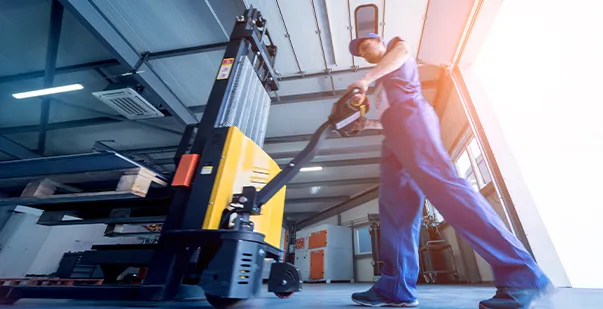Heavy lifting is an everyday aspect of many workers' jobs, especially warehouse, department store, and delivery employees. To make the job easier and safer, many workers use a device called a pallet jack. This small but powerful device helps move heavy pallets without having to lift them. Do you know that pallet jack operation, especially electric pallet jack operation, requires training and certification? If they are not trained, workers may be injured or cause accidents. But what is pallet jack certification, and who needs it? This guide will explain everything, including how long training takes and the easiest way to become certified. Let's get started!
What Is Pallet Jack Certification?
A pallet jack is also known as a pallet truck or pump truck. It is a material-handling tool designed to lift and move palletized loads over short distances. It is widely used in warehouses, retail stores, supermarkets, and distribution centers. Pallet jacks are available in two forms:
Manual, which relies on hand-pumped hydraulic pressure, and
Electric, which uses a battery-powered motor to make lifting and moving much easier.
Pallet jack certification is formal training that teaches workers how to safely operate these tools. The certification is especially important for electric pallet jacks, as OSHA requires all powered industrial truck operators to be trained and evaluated.
Certification ensures operators know proper handling, safety checks, and accident prevention techniques.
Even for manual pallet jacks, training improves workplace efficiency and reduces risk.
Overall, certification promotes safety, compliance, and smoother day-to-day operations.
Pallet jacks can typically carry between 2,500 to 5,500 pounds (1,100 to 2,500 kg), depending on the model. Though small, they are vital for efficient material handling and logistics.
If used improperly, pallet jacks can cause muscle strain, pinch injuries, or even load instability, so proper safety training and certification are essential for operators. According to a 2024 report from the U.S. Government Accountability Office (GAO), serious injury rates among warehouse workers increased by 20% between 2018 and 2022. Even last-mile delivery workers rose by 23% over the same period, underscoring that musculoskeletal strain (often due to equipment use like pallet jacks) remains a major hazard in modern settings.
Who Should Enroll in a Pallet Jack Training?
Anyone who operates a pallet jack, whether frequently or occasionally, needs proper training to stay safe and compliant. Here’s who benefits most:
Warehouse Workers: Moving and shelving inventory safely without strain or accidents.
Stock Clerks: Placing goods onto shelves while maintaining efficiency and safety.
Delivery Drivers: Transporting shipments without risking damage or injury.
Retail Staff: Handling store supplies with confidence and care.
Shipping & Receiving Teams: Managing daily deliveries while avoiding costly mishaps.
Even occasional operators require certification since OSHA mandates training for powered industrial truck operators, including electric pallet jack users. While manual pallet jacks may not always require certification, training still ensures safer handling and smoother workflows.
Now that we know what pallet jack certification is and who needs it, let us see how it is different from a forklift.
Read More: What Do Heavy Equipment Operators Do?
Pallet Jacks vs. Forklifts: What’s the Real Difference?
According to OSHA, electric pallet jacks are classified as powered industrial trucks, placing them in the same category as forklifts. As a result, they require the same level of certification and training under OSHA regulation 29 CFR 1910.178.
However, manual pallet jacks are not powered, so they are not considered forklifts and generally do not require OSHA-level certification. Still, employers should provide safety training to help reduce risks such as strain injuries and load instability.
The differences between them are:
Read More: Manual vs. Electric Pallet Jack Certification Overview 2025
OSHA Guidelines for Pallet Jack Operator Training
As per OSHA standard 29 CFR 1910.178(l)(2)(ii), pallet jack operators must first receive formal instruction. This may include classroom training, online courses, or other educational formats such as videos and manuals. The goal is to teach basic operating principles, safety guidelines, and hazard awareness before the worker uses the equipment.
Practical Training with the Actual Equipment
OSHA requires hands-on training using the same type of pallet jack the operator will use on the job. This includes supervised practice in load handling, steering, starting, stopping, and navigating tight spaces. Practical training helps employees gain real experience and build confidence before operating independently.
Performance Evaluation by Employer
According to 29 CFR 1910.178(l)(2)(iii), employers must evaluate each operator’s performance. This includes checking whether the operator uses the equipment correctly and safely. A qualified and experienced individual must conduct the evaluation. This step ensures that only competent workers operate electric pallet jacks.
Training Must Cover Site-Specific Hazards
Operators must be trained on hazards specific to their actual worksite. This includes operating near loading docks, ramps, tight aisles, and pedestrian zones. OSHA emphasizes that training must reflect the real working environment so employees are fully prepared for the conditions they’ll face daily.
Retraining Is Required After Certain Incidents
OSHA regulation 29 CFR 1910.178(l)(4) says retraining is mandatory if an operator is in an accident, sees unsafe practices, or is assigned a different type of equipment. Retraining reinforces safety and helps prevent future workplace injuries or compliance violations.
How Long Will It Take You To Get Pallet Jack Certified?
Electric pallet jack license training is generally brief and can be completed in just half a day. Total training time typically ranges around hours, depending on the training provider and workplace setting.
The training consists of three parts:
Some providers offer online certification for the theory portion, which adds flexibility. However, OSHA still requires a site-specific performance evaluation to confirm the operator’s ability to use the pallet jack safely in their actual workplace. Certification ensures compliance with OSHA standard 29 CFR 1910.178.
Read More: How OSHA Enforces Its Standards: An Overview of the Process
How to Get Pallet Jack Certification Easily
If you're an employer looking to ensure your team is qualified to operate pallet jacks safely, it's important to understand what pallet jack certification is and how to get it. To get certified easily, follow the given steps:
Choose a Certified Training Provider
Select a training provider that offers an OSHA-compliant pallet jack license. Some providers offer online modules for the theory portion, while others provide on-site practical instruction. Make sure the program includes both formal instruction and a performance evaluation, as required by OSHA standards (29 CFR 1910.178).
Schedule Training Sessions
Plan training at a convenient time for your team. This can include in-person sessions at your facility or virtual learning platforms for the classroom portion. However, the hands-on operation assessment must always be conducted on-site using the actual equipment.
Provide Site-Specific Operational Training
Training should include site-specific safety protocols. For example, employees should learn how to operate the pallet jack safely in their work environment. This may involve navigating ramps, working around foot traffic, or handling specific load types. OSHA requires that training be tailored to the actual conditions of use.
Maintain Certification Records
After successful training, issue a certificate of completion to each employee. Keep a copy on file, including dates of training, type of equipment used, and the trainer’s credentials. These records are essential during OSHA audits or workplace inspections by OSHA inspectors.
Conduct Re-Evaluations Every Three Years
OSHA mandates a performance re-evaluation of all powered pallet jack operators every 36 months. Re-training may be required sooner if an employee:
Is involved in a workplace incident
Is observed using unsafe practices
Is assigned a different type or model of pallet jack
Routine re-evaluation ensures ongoing operator competence and helps reduce ergonomic and mechanical hazards in the workplace.
Get Pallet Jack Certified: Lead with Safety!
Using a pallet jack may seem simple, but it comes with real risks, especially when operating electric pallet jacks. That is why it is important to be aware of what pallet jack certification is. The training and certification of all-electric pallet jack operators are required by OSHA to provide a safe workplace. Although you might only operate a pallet jack occasionally, training avoids accidents and operating errors. Although certification is not needed for manual pallet jacks, safety training is also a good and responsible choice. As a manager or employee, pallet jack training is a quick, effective way to protect yourself and your staff on the job.
References:
https://www.forkliftcertification.com/pallet-jacks
https://afewimports.com/warehouse-fulfillment/pallet-jack-certification





